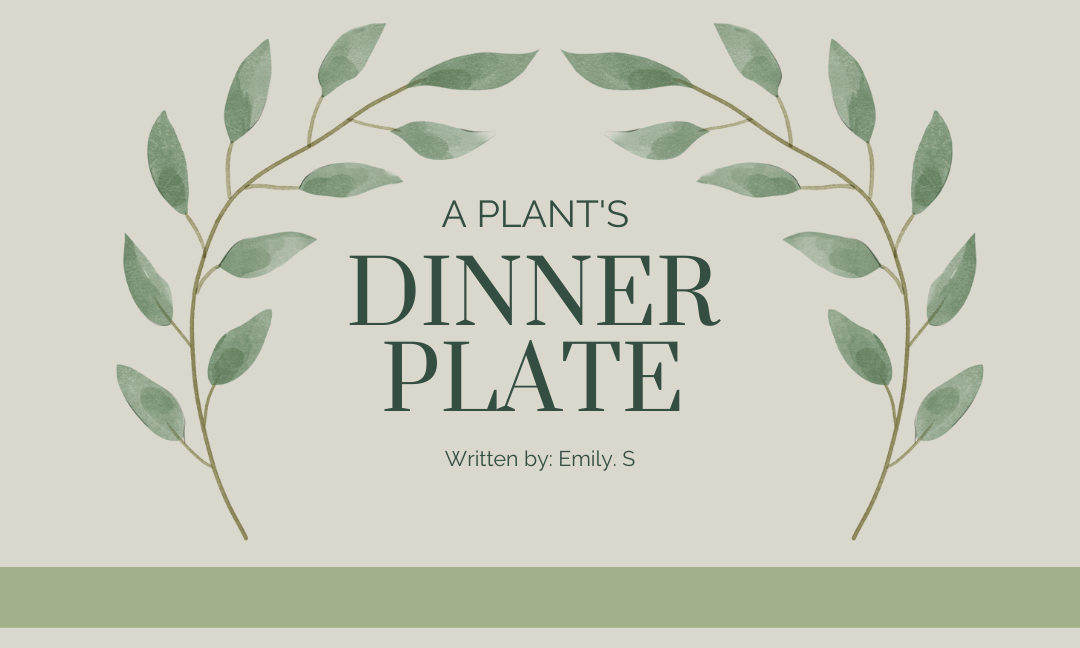Written By: Emily Sheng
Edited by: Tiana Mair
Designed By: Jiya
Published By: Maryam Khan
As humans, our bodies need food to grow big and healthy. You may remember drinking milk as a child to grow strong bones, or eating fruits and vegetables to stay healthy. But how exactly do plants grow? What kind of food does the rose in your garden eat to bloom those vivid pink petals? How did that sapling in the park grow so tall, taller than you in the span of a few years? They don’t have mouths, so how can we be sure that they eat at all? In our eyes, plants don’t eat. Days go by and the plant never even stops by the dinner table to pick up dessert. However, concealed by the limitations of human sight and revealed underneath the microscope and through decades of research done by scientists, plants do in fact eat. They eat quite a lot, just not in the same way as us.
Instead of eating something from the fridge and having a stomach break it down, plants make their own food. Photosynthesis is the main process that plants use to create glucose, a type of sugar, which they use to grow. Sunlight, carbon dioxide, and water are important substances needed in order for this process to occur. Water is absorbed into the plant through the roots, then carbon dioxide is acquired from the air through the leaves and stems, and finally, small organelles within the cells of the leaves, called chloroplasts, trap sunlight.. These three are the main ingredients that a plant needs and make up most of the plant “diet”.
However, those aren’t the only things that plants need to grow. Nutrients in the soil are a big component as well. Just like how humans need nutrients to grow and fight off disease, plants need these nutrients as well, except instead of getting them from a delicious meal, they receive them straight from the soil. Nitrogen is found in all cells of the plant as well as plant proteins and chloroplasts. Plants take up the mineral form of nitrogen, nitrate, through the roots. Phosphorus in the soil aids in energy transfer from sun to plants and promotes growth and maturity. Manures are phosphorus-rich, which is why many farmers and gardeners lay down a manure mixture for their crops. Potassium helps plants to build disease-resistance and move resources through the plant, as well as helps to improve the taste of vegetables and fruits. Calcium improves root growth and leaf development. Magnesium is important for photosynthesis and chloroplasts. Various other elements such as iron, zinc, and copper play roles in plant growth as well.
When many plants, especially of the same type, are planted close to each other, the amount of nutrients in the soil depletes extremely quickly, and the plants no longer have enough nutrients to sustain themselves. This is why all kinds of fertilizers are used to help replenish the soil of its nutrients. Some natural and organic fertilizers such as manure, bone, and compost are much gentler on the environment, but take more time to become effective. . Synthetic chemicals used as fertilizers are more used commercially but can have harmful effects on the environment, with runoff leaching into rivers and the local ecosystem, as well as posing potential health risks when the water and food containing this fertilizer is consumed.
By harnessing resources around itself, even the most feeble plants can grow to produce beautiful flowers. While it might not be your average steak dinner, plant “food” is still amazing and important for healthy growth.
References
How Plants Use Nutrients. (2021, August 01). Retrieved from https://extension.wvu.edu/lawn-gardening-pests/news/2021/08/01/how-plants-use-nutrients
Photosynthesis. (n.d.). Retrieved from https://education.nationalgeographic.org/resource/photosynthesis
Plant nutrients in the soil. (1970, January 01). Retrieved from https://www.dpi.nsw.gov.au/agriculture/soils/soil-testing-and-analysis/plant-nutrients#:~:text=Soil is a major source,are calcium, magnesium and sulfur.
What is Photosynthesis. (2018, March 27). Retrieved from https://ssec.si.edu/stemvisions-blog/what-photosynthesis
White, A. (2022, April 07). Plant Nutrients: What They Need and When They Need It. Retrieved from https://gardenerspath.com/how-to/composting/plant-nutrients/

